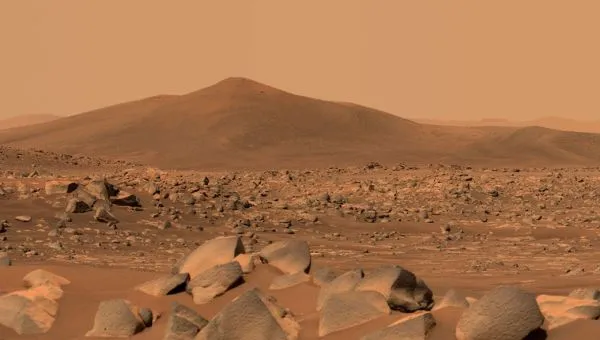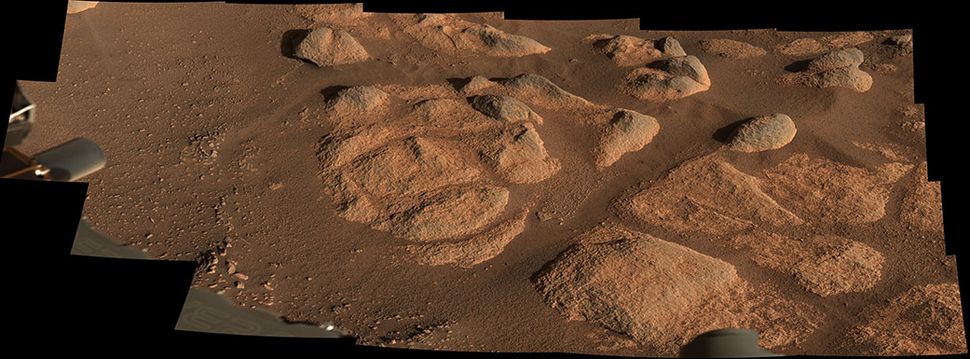NASA's Perseverance rover on Mars has found some mysterious rocks (photos)
화성에서 미 항공우주국(NASA)의 인내 탐사선이
불가사의한 암석(사진)을 발견했다.
By Mike Wall - Space.com Senior Writer 9 days ago
9일 전 Space.com 선임 작가-마이크 월에 의한 글
Mission scientists are keen to know the rocks' origin.
임무 과학자들은 그 바위의 기원을 알고 싶어 한다.

NASA's Perseverance Mars rover used its dual-camera Mastcam-Z imager to capture this image of "Santa Cruz," a hill within Jezero Crater, on April 29, 2021. (Image credit: NASA/JPL-Caltech/ASU/MSSS)
미 항공우주국(NASA)의 인내 화성 탐사선은
2021년 4월 29일 듀얼 카메라 마스트캠-Z
이미저를 이용해 제제로 분화구 내 언덕
'산타 크루즈'의 아래 모습을 촬영했다.
(이미지 저작권: NASA/JPL-Caltech/ASU/MSS)
NASA's Mars rover Perseverance is starting to take the measure of its new Red Planet home.
NASA의 화성 인내 탐사선이 그것의 새로운
화성 고향을 측정하기를 시작하고 있다.
For the past five weeks, Perseverance has been focused primarily on supporting and documenting the pioneering flights of its little cousin, NASA's 4-lb. (1.8 kilograms) Mars helicopter Ingenuity. But the car-sized rover has been doing science work of its own in the background as well.
지난 5주 동안, 인내선은 주로 그것의 어린
사촌인 나사의 4파운드(1.8킬로그램)급 창의적
화성 헬리콥터의 선구적인 비행을 지원하고
기록하는데 초점을 두었다.
하지만, 이 자동차 크기의 탐사선은 그것 자신의
뒷면에서도 과학적 연구를 해오고 있다.
For example, Perseverance has extensively photographed its surroundings — the boulder-studded floor of Mars' 28-mile-wide (45 kilometers) Jezero Crater, where the rover and chopper touched down on Feb. 18 — with its high-resolution Mastcam-Z imaging system.
예를 들어, 인내선은 2월 18일 탐사선
헬리콥터가 착륙한 화성의 너비 28마일 (45
킬로미터) 제제로 분화구의 바위가 박힌
바닥인 그것의 주변을 고해상도 마스트캠-Z
영상 시스템으로 광범위하게 촬영했다.
In photos:
NASA's Perseverance rover mission to the Red Planet
사진에서:
화성에 대한 NASA의 인내 탐사선 임무

NASA's Perseverance rover viewed these rocks with its Mastcam-Z imager on April 27, 2021. (Image credit: NASA/JPL-Caltech/ASU/MSSS)
나사의 인내 탐사선은 2021년 4월 27일 마스트캠-Z
이미저로 이 암석을 관측했다. (이미지 저작권: NASA/JPL-Caltech/ASU/MSS)
Perseverance has also studied nearby rocks in greater detail using two other instruments: its rock-zapping SuperCam laser and the WATSON ("Wide Angle Topographic Sensor for Operations and Engineering") camera at the end of its robotic arm.
인내선은 또한 그것의 로봇 팔의 끝에 있는
두 개의 다른 기구인 바위-제압용 슈퍼캠
레이저와 왓츠(WATS: "운영 및 엔지니어링용
광각 지형 센서") 카메라를 사용하여 근처의
암석을 더 자세히 연구했다.
The mission team is keen to know whether the stones are volcanic or sedimentary in origin. Volcanic rocks can serve as geological clocks, allowing researchers to better understand the history and evolution of Jezero, which hosted a lake and a river delta billions of years ago. And sedimentary rocks, which form through the deposition of dirt and sand over time, have greater potential to preserve signatures of Mars life, if it ever existed at Jezero.
임무팀은 이 돌들이 기원에서 화산성인지 퇴적성
인지 알고 싶어 한다.
화산암은 지질학적 시계 역할을 할 수 있어, 연구원
들을 수십억 년 전 호수와 강의 삼각주를 수용했던
제제로의 역사와 진화를 더 잘 이해할 수 있게 해
준다.
퇴적암은 시간이 지남에 따라 흙과 모래의 퇴적물
을 통해 형성되며, 만약 제제로에 퇴적암이 존재하기
라도 한다면, 생명체의 흔적을 보존할 수 있는 더 큰
잠재력을 가지게 된다.
Hunting for biosignatures is one of Perseverance's two core mission tasks, along with collecting and caching several dozen samples of potential astrobiological significance. That pristine Mars material will be hauled to Earth by a joint NASA-European Space Agency campaign, perhaps as early as 2031.
바이오 시그너처(biosignature: 생명체를 과학적으로
증명하는 측정할 수 있는 속성, 특성 및 효과) 사냥
은 잠재적인 우주 생물학적 중요성에 대한 수십 개
의 샘플을 수집하고 보관하는 것과 함께 인내선의
두 가지 핵심 임무 작업 중 하나이다.
이 청정 화성 물질은 이르면 2031년 NASA와 유럽
우주국(European Space Agency)의 합동 활동에
의해 지구로 운반될 것이다.
Determining the Jezero rocks' origin may require abrading their surfaces and obtaining compositional information from their interiors using two other instruments on the robotic arm, PIXL ("Planetary Instrument for X-ray Lithochemistry") and SHERLOC ("Scanning for Habitable Environments with Raman & Luminescence for Organics & Chemicals").
제제로 바위의 기원을 결정하려면 그 로봇 팔의 다른
두 기구인 PIXL("X선 석화학을 위한 행성용 기구")과
SHERLOC("유기화학물질의 주거환경에 대한 라만
분광계")를 사용하여 표면의 마멸정도와 내부로부터의
구성 정보를 필수적으로 할 수도 있다.
"When you look inside a rock, that's where you see the story," Perseverance project scientist Ken Farley, of the California Institute of Technology in Pasadena, said in a statement.
패서디나에 있는 캘리포니아 공과대학의 과학자 켄 팔리
는 성명을 통해 "바위 속을 들여다보면 이야기가 바로
거기서 나온다"고 말했다.
Perseverance is set to ramp up its science work considerably, for its days as a helicopter observer are mostly over. Ingenuity wrapped up its main technology-demonstrating mission last week and is now embarking on an extended mission designed to showcase the scouting potential of Red Planet rotorcraft.
인내선은 헬리콥터 관찰자로서의 날들이 거의 끝나감에
따라 과학 연구를 상당히 늘릴 예정이다.
헬리콥터는 지난 주에 주요 기술 입증 임무를 마치고
현재 화성 회전 날개 헬리곱터의 발굴정찰의 잠재력
을 보여주기 위해 고안된 확장 임무에 착수하고 있다.
So Ingenuity will continue to fly for a while, on sorties that could help the Perseverance team pick the most efficient routes and identify rock formations that merit up-close inspection.
따라서, 헬리콥터는 . 인내선 팀이 가장 효율적인 경로를
선택하고 정밀 검사를 할 가치가 있는 암석 정보를 확인
하는 데 도움을 주게되는 분류차 당분간 계속 비행할 것이다
Mike Wall is the author of "Out There" (Grand Central Publishing, 2018; illustrated by Karl Tate), a book about the search for alien life. Follow him on Twitter @michaeldwall. Follow us on Twitter @Spacedotcom or Facebook.
Mike Wall은 외계 생명체를 찾는 것에 관한 책 《Out There》
(Grand Central Publishing, 2018; 삽화: Karl Tate)의 저자이다.
트위터 @michaeldwall에서 그를 팔로우하세요.
Twitter @Spaceotcom 또는 Facebook에서 팔로우하십시오.

댓글 없음:
댓글 쓰기